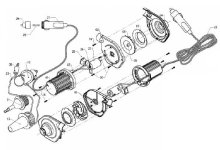TylerDurden
100 GW
This post was a good thought for a new thread (so I'll take the liberty):
I saw this online yesterday (maybe overkill):

http://www.harborfreight.com/cpi/ctaf/displayitem.taf?Itemnumber=97619
Small and compact handy inflator/deflator includes three adapters for most inflatables.
Plugs into a vehicle cigarette lighter port
Convenient on/off switch
6 foot, 8" long power cord
Operating pressure: 0.5 PSI; Pump dimensions: 5" L x 5" W x 3-7/8" H
Net weight: 0.65 lbs.
ITEM 97619-1VGA $7.99

oofnik said:Hey guys, random idea that just occurred to me... since we don't all have fancy 5-axis CNC machines, but we would still like to keep our little RC motors cool, we can use impellers designed to keep vacuum cleaner motors at operating temp. A wide variety is available on eBay. Just take a look at these search results. I asked a few sellers for diameters and am awaiting replies. Shouldn't be too hard to adapt most of these to RC motors.
I saw this online yesterday (maybe overkill):

http://www.harborfreight.com/cpi/ctaf/displayitem.taf?Itemnumber=97619
Small and compact handy inflator/deflator includes three adapters for most inflatables.
Plugs into a vehicle cigarette lighter port
Convenient on/off switch
6 foot, 8" long power cord
Operating pressure: 0.5 PSI; Pump dimensions: 5" L x 5" W x 3-7/8" H
Net weight: 0.65 lbs.
ITEM 97619-1VGA $7.99





